John Boggust, 1837 - 1921
by Brian Stevenson
last updated November, 2020
John Boggust was a middle-class, working man. He was a carpenter/joiner and foreman of building crews, who appears to have picked up microscopy as a hobby when in his 40s. His interest is first noted in 1880, when he offered in Hardwicke’s Science-Gossip to exchange collectible coins and other items for “slides of diatoms, foraminifera, or any other items of interest”. During 1882, Boggust offered items in exchange for a section-cutter, implying that he was just then exploring the production of thin-sections. In 1892, he gave readers of Hardwicke’s Science-Gossip hints on mounting butterfly tongues (see below). That is the last identified record of Boggust’s microscopy, although it is probable that such a hobbyist would have continued with his pastime, even if not advertising in exchange columns.
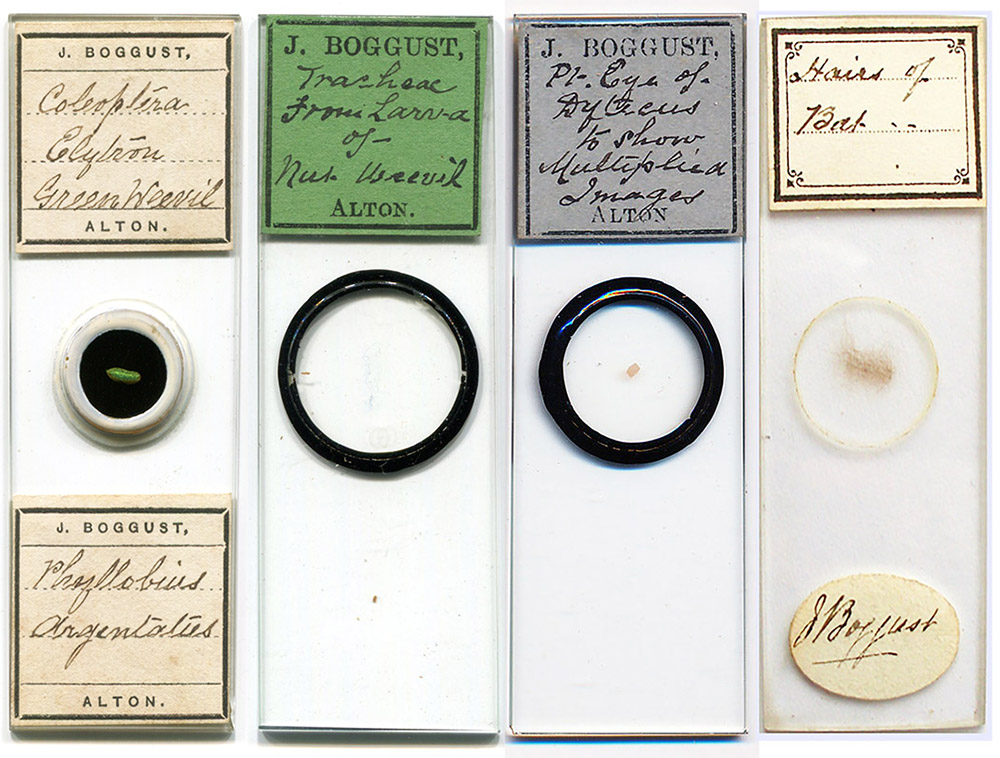
Figure 1.
Microscope slides by John Boggust, ca. 1880 – ca. 1892. The right-hand slide, with the handwritten signature, is probably an early product, before he bought custom, type-set labels. Slides from the author’s collection or adapted from internet sites for nonprofit, educational purposes.
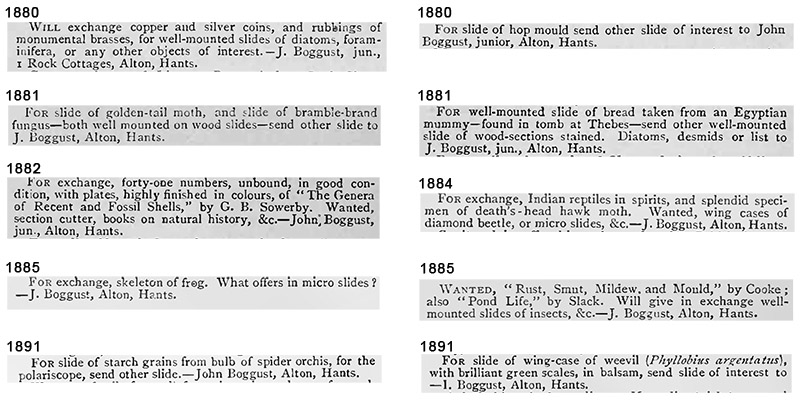
Figure 2.
Offers from John Boggust to exchange microscope slides and other items with other amateurs, all from “Hardwicke’s Science-Gossip”. These are the earliest and latest identified exchange offers. The “bread” from a mummy, offered in 1881, is probably a typographical error – “beard” makes much more sense. His 1884 through 1885 advertisements offered scientific objects – preserved reptiles and a frog skeleton – for microscope slides, suggestive of a change of interests from the macro- to the micro-scopic.
John Boggust was born in Farringdon, Hampshire during late 1837, and christened on November 19 of that year. He was the oldest of six children of John and Mary Boggust. John Senior was a carpenter and construction foreman, an occupation followed by our microscopist. The Boggusts appear to have been middle-class: they did not have servants, but they could afford to have the children stay in school until their mid-teens. The family moved to nearby Alton, Hampshire, when John was 1-2 years old.
Our John married Priscilla Jarvis in 1859. The couple lived two houses away from John’s parents for many years – hence his notation of “junior” in exchange offers, to ensure that post came to him and not his neighbor father. His father died in 1888. John and Priscilla did not have any children.
The growing town of Alton built a new church, All Saints, in 1873-1874. The stone baptismal font is inscribed "This Font was carved by J. Boggust, jun., and W. Pickett, in their leisure hours, as their contribution to this Church, 1874".
It is not certain when John Boggust first became serious about microscopy. As noted above, he offered to exchange various items for slides in 1880. That year, and into the next, he offered slides of “hop mould” for exchange – possibly a common item in his neighborhood that Boggust learned to mount and that was evidently of interest to other people. In 1881, he offered to exchange preparations of moths and bramble-brand fungus, that were mounted in wooden slides. To judge from the mounting material, those were probably dry-mounts of unfastened specimens – a relatively simple process. He sought a microtome in 1882, also suggestive of a beginning mounter. By 1885, however, Boggust was offering “well mounted slides” in exchange for items. He may have made the offered slides, although they may also have included undesired acquisitions.
In addition to microscopy, Boggust professed an interest in other aspects of science. In 1881 and, again, in 1882, he wrote articles on swallows for Hardwicke’s Science-Gossip. His biological interests were evidently known to friends, as he once found a hornet “pinned on my front door”, and a Sirex juvencus saw fly was “sent me securely fastened up with string in a paper box labeled ‘Mind the sting’.”.
Boggust published a short article in 1890 on a working table for arranging and mounting microscopical specimens. His device is simple and likely useful for modern microscopists: “one I have used for a long time, and found to answer well for dissecting purposes. It is easily made, very portable, and could be manufactured out of an old cigar box; and from the sketch will need very little explanation. It is made of pine about 3/8 of an inch in thickness, with a small drawer at the back to hold all necessary dissecting instruments, brushes, watchglasses, knives, &c. A piece of glass is fitted in the top on which the watch-glass or glass trough is placed for working purposes. For a lens I use one on a brass stand, such as is used for botanical purposes. For a mirror I have a piece of an old looking-glass, cut to size, and put in a slanting position so as to reflect the rays of the lamp up through the watchglass”. (see Figure 3).
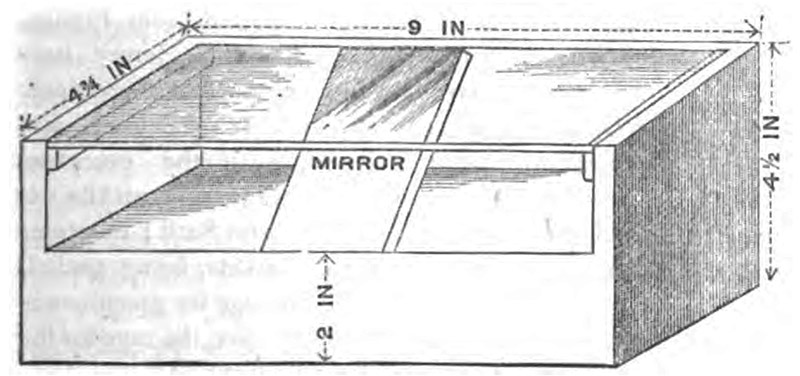
Figure 3.
John Boggust’s “handy block for work-table”, as drawn by him and described in 1890.
Growing in expertise, Boggust wrote on his method of mounting butterfly tongues in 1892, “First take a fine-pointed pair of scissors and carefully cut out the tongue as close up to the mouth of the insect as possible, and see that the tongue is in a nice flat spiral form. Put it into spirits of wine for a few days; take out and put into good clear turpentine, in which it will have to stay for some time, to take out a little of the dark colour, or you will not be able to see the tracheal tubes nicely. After you have taken out sufficient colour, place the tongue in benzol for a couple of days; then into oil of cloves, to make transparent. Now take a 3 x 1 glass slip, on which you have fastened a tin cell of sufficient depth to take the tongue. Fill up the cell with balsam and benzol until it is nicely rounding on the top/put in the tongue, place on the cover glass, but do not press the glass circle close on to the tin first off; give the benzol time to evaporate, after which you may press the circle down, and when the edge of balsam is hard, ring with shellac cement, finishing off with any fancy colour you like.”
A nice example of Boggust’s expertise as an illustrator can be seen in his 1892 “Singular beak of fowl”, “I take the liberty to send you a rough sketch of the head of a fowl, showing the curved and hawk-like shape of the upper mandible of the beak, giving the head the appearance of a bird of prey” (Figure 4).
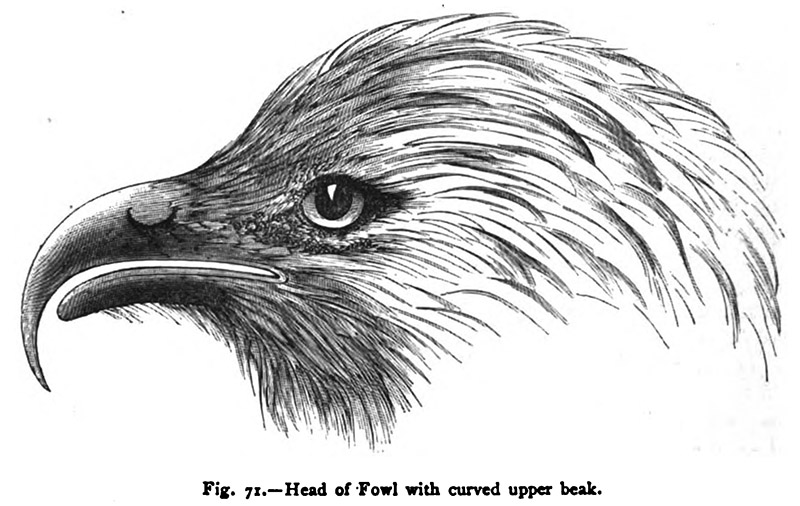
Figure 4.
An 1892 illustration of a chicken’s head, by John Boggust.
John’s wife, Priscilla, died in 1894. In the time between 1901 and 1911, John retired and moved to Birmingham to live with his younger brother, Alfred, who was a school headmaster. John Boggust died at a nearby hospital in 1921.
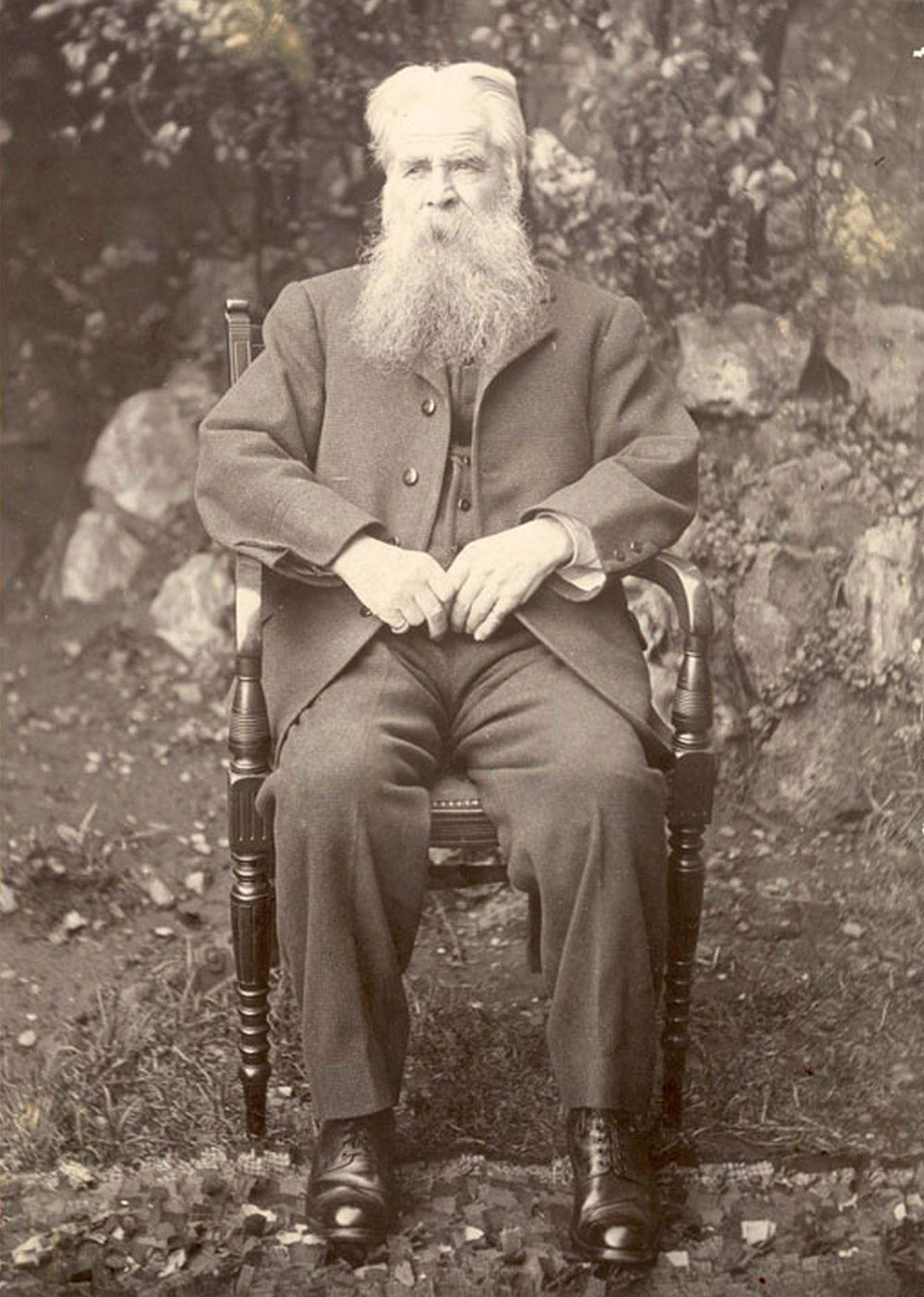
Figure 5.
John Boggust, late in life. Adapted for nonprofit, educational purposes from https://collections.hampshireculture.org.uk.
Acknowledgement
Thank you to Jane Hurst for sharing information on John Boggust’s life, and for directing me to the photograph of Boggust.
Resources
Boggust, John (1881) The domestic arrangements of swallows, Hardwicke’s Science-Gossip, Vol. 17, page 263
Boggust, John (1882) The domestic arrangements of swallows, Hardwicke’s Science-Gossip, Vol. 18, page 238
Boggust, John (1890) Handy block for work-table, Hardwicke’s Science-Gossip, Vol. 26, page 187
Boggust, John (1891) Note on Sirex juvencus, Hardwicke’s Science-Gossip, Vol. 27, page 147
Boggust, John (1892) How to mount tongue of moth or butterfly, Hardwicke’s Science-Gossip, Vol. 28, pages 44-45
Boggust, John (1892) Singular beak of fowl, Hardwicke’s Science-Gossip, Vol. 28, page 116
Bracegirdle, Brian (1998) Microscopical Mounts and Mounters, Quekett Microscopical Club, London, pages 15 and 116, Plate 6-M and 6-N
Curtis, William (1896) A Short History and Description of the Town of Alton, Warren & Son, Winchester, page 100
England census, birth, marriage, and death records, accessed through ancestry.com
Hardwicke’s Science-Gossip (1880) Exchange offers from John Boggust, Vol. 16, pages 192 and 284
Hardwicke’s Science-Gossip (1881) Exchange offers from John Boggust, Vol. 17, pages 71, 120, and 168
Hardwicke’s Science-Gossip (1882) Exchange offers from John Boggust, Vol. 18, pages 24 and 192
Hardwicke’s Science-Gossip (1884) Exchange offers from John Boggust, Vol. 20, pages 48 and 168
Hardwicke’s Science-Gossip (1885) Exchange offers from John Boggust, Vol. 21, pages 216 and 263
Hardwicke’s Science-Gossip (1887) Exchange offer from John Boggust, Vol. 23, page 284
Hardwicke’s Science-Gossip (1891) Exchange offers from John Boggust, Vol. 27, pages 72 and 284
Hardwicke’s Science-Gossip (1892) “J. Boggust - Accept our best thanks for the beautiful mount of tongue of privet hawk moth. We are pleased to call the attention of our readers to your method in our microscopical column”, Vol. 28, page 47
Microscopical News and Northern Microscopist (1881) Exchange offer from John Boggust, Vol. 1, page 24
Papers and Proceedings of the Hampshire Field Club (1888) List of members, Vol. 1
Papers and Proceedings of the Hampshire Field Club (1891) List of members, Vol. 2
Probate of John Boggust (1921) “Boggust John of 79 Summerfield-crescent Birmingham retired builders foreman died 18 July 1921 at Western-road Infirmary Birmingham Probate Birmingham 19 September to Alfred Boggust schoolmaster. Effects £594 10s”, accessed through ancestry.com




